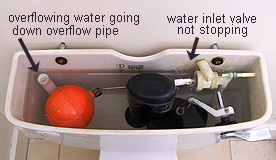 |
 |
Home
Tools
Drilling and Fixing
Putting Things Up
Repairs/Maintenance
Plumbing
Electrics
Woodwork
Decorating a Room
Tiling
Safety & Security
Saving Energy
House and Finance
Health&Safety
Disclaimer
Contact
Advertising
Useful Links
Site Map
| Toilet cistern/water tank over flowing | ||||||||||||||||||||
Toilets and water tanks are fed by water via a valve which automatically stops when they are full. In some modern toilet cisterns the siphon diverts water into the pan when the valve fails so you might see a constant trickle going down the pan (and wasting water). |
||||||||||||||||||||
Toilet Cistern |
||||||||||||||||||||
 |
||||||||||||||||||||
| Some are bottom entry and some are side entry. Side entry ones are easier to change. If it's bottom entry you'll have to drain the toilet cistern completely. Take out the remaining water from the bottom with a sponge. | ||||||||||||||||||||
Using a footprint wrench or adjustable spanner unscrew the bottom of the valve from the water intake pipe. Then unscrew it from the cistern. |
 |
|||||||||||||||||||
If you do have an old ball cock type you may like to replace it with a more modern type which tend to fill more quickly and quietly.(like a Torbeck or Fluidmaster valve) It has a tiny float compared to a ball cock type. |
 |
|||||||||||||||||||
| Bottom entry Torbeck valve. Very quiet and quick filling. Approx. £12 | ||||||||||||||||||||
Water tank |
||||||||||||||||||||
| A portsmouth valve with a ball cock can be quickly adjusted by bending the brass arm. Bending it down will stop the water more quickly. Make sure the water stops an inch or two lower than the overflow outlet. |  |
|||||||||||||||||||
| Brass valve with float. Approx. £6 | ||||||||||||||||||||